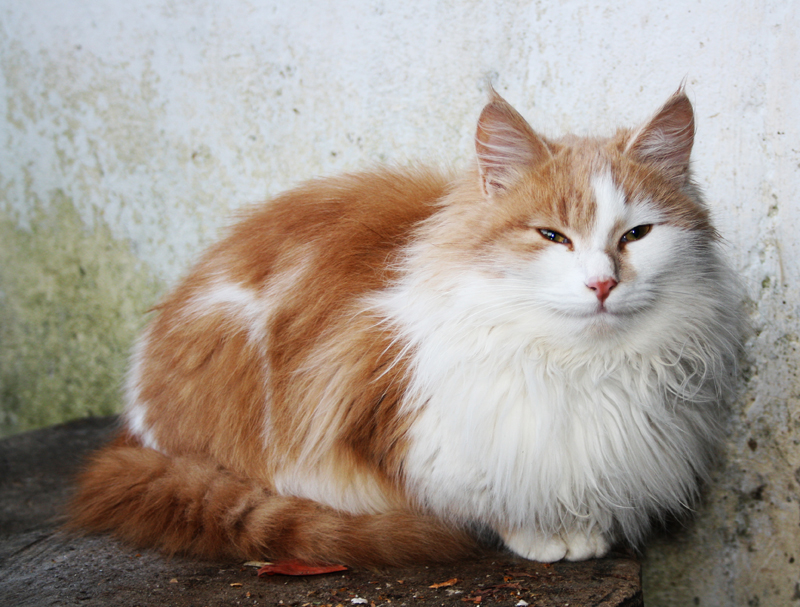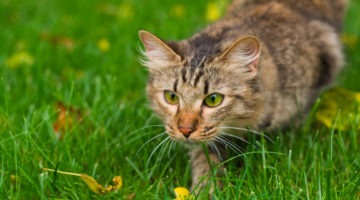Cats can live long lives, but are more prone to certain health issues as they get older. Here’s a look at four of the most common, and how you can help prevent or control them.
Cats are by nature a hardy species. They’re capable of living more than 20 years. But just like us, they’re susceptible to a variety of so-called natural infirmities of age. We also have to add to this list of health issues a number of unnatural diseases caused by how we care for our cats.
The truth is, we have taken cats out of their natural outdoor element and created a captive situation for them. We do this to protect them, of course, but we have also failed to provide them with some of the things they need to stay healthy, and which they can no longer provide for themselves. One of the most important of these is diet.
Let’s take a look at four of these health issues, and what you can do about them.
1. Obesity
The problem: Many if not most cats are overweight, and some are obese. Obesity in cats is just as damaging as it is in humans. After 31 years in veterinary medicine, it has become clear to me that feeding a completely unnatural diet of low quality processed carbohydrate-laden dry food lies at the root of this disease in the cat. All zookeepers know that wild cat species must eat diets of fresh meat, organs and bone to live long healthy lives. For this reason, no wild cats in captivity are fed cereal-based diets. Yet the majority of household cats eat cheap, poor quality over-processed cereal their entire lives. It’s no wonder so many are overweight.
The signs: If your cat weighs more than nine to eleven pounds, the average healthy weight for the “domestic” feline, it is extremely likely he is carrying excess weight.
The solution: You will be surprised how easily your overweight cat will shed those extra pounds once you switch his diet to either a good homemade meat-based diet or a high quality canned cat food with supplemental meat and dairy (cheese, yogurt and the like) from your own table. These foods provide less starch and sugar and more of the protein and essential fatty acids your feline needs. Most cats need about six to eight ounces of “wet” diet daily, usually divided into two or three meals.
2. Diabetes mellitus
The problem: Like obesity, adult-onset diabetes mellitus is epidemic in cats. Its cause, as with humans, is excessive sugar and starchy food consumption. Because the cat is a strict carnivore, while humans are omnivores, high carbohydrate diets are even more harmful for cats than they are for people! Many diabetic cats are overweight, but not all are.
The signs: Cats with diabetes have excessive thirst and urinate more than usual. As the disease progresses, they lose weight, may become very lethargic, and their coats become dull and dry. They may vomit and become dehydrated even though they are drinking plenty of water. Any of these signs signals the need for immediate veterinary attention.
The solution: The diabetic cat will show some improvement as soon as his diet is changed to the same wet low carb food as for the overweight cat. While a low carb diet may be enough to control this disease, many diabetics will also need insulin. I advise all my clients to learn to test their cat’s blood glucose at home just as a human with this disease would do. It’s remarkably easy and critical for the proper management and correct administration of insulin.
Indoor cats may become bored and inactive, especially as they get older. This can contribute to obesity. Engage your feline in some daily interactive exercise, even if just for a few minutes at a time.
3. Hyperthyroidism
The problem: An astonishing number of cats over ten develop an overactive thyroid gland, called benign thyroid hyperplasia. Hyperthyroidism is by far the most diagnosed disease of cats in their middle and senior years. We do not yet know all the causes, but there is no question it has its roots in the indoor cat’s environment. Recently, researchers found that cats with hyperthyroidism have high levels of certain chemicals in their bodies – the same chemicals used as fire-retardants in carpets and household fabrics. Some veterinarians believe that additives in commercial pet foods, such as supplemental iodine, may also be a cause. There may be other causes as well, but the fact remains that as the years pass, the indoor cat is increasingly exposed to these toxic factors and may develop full blown disease.
The signs: Hyperthyroid cats show a wide variety of clinical signs. The most common are gradual, unexplained weight loss, excessive water drinking and urinating, hyperactivity or lethargy, voracious appetite or loss of appetite, and vomiting with or without loose stools. Signs you won’t notice but which are very dangerous include high blood pressure, too-rapid heart rate and eventual kidney failure. It is very important to notice the early signs and seek veterinary assistance as soon as possible. Any cat over ten years of age should have a thyroid panel run yearly.
The solution: Because we do not know the exact environmental causes of hyperthyroidism, early diagnosis is the best way to prevent the disease from becoming life threatening. Once your cat has it, he’ll need a course of medication to reduce thyroid hormone production; the “gold standard” treatment is curative radioactive iodine therapy, which eliminates the problem in 95% of all affected cats.
4. Chronic kidney insufficiency (CRI)
The problem: Cats can develop signs of kidney problems at any age, but usually when they are seven or older. In fact, chronic kidney disease is common in older cats, but with prompt and proper treatment they can live happily for many years after diagnosis. We don’t know the exact cause of the disease, although some breeds have congenital or inherited problems. Most cats, however, simply begin to show signs with no known predisposition. Once again, it is my opinion that an over-processed low protein diet lacking in fresh ingredients and antioxidants is likely to be at least part of the problem.
The signs: The cat with CRI may begin to drink excessively and produce large quantities of dilute urine. In this respect, CRI looks very much like diabetes and hyperthyroidism at first. If the condition progresses, the patient will stop eating, lose weight, and begin to vomit. High blood pressure is also a common consequence of CRI. Prompt diagnosis is very important.
The solution: The cat with CRI will respond to a variety of treatments and medications depending on the severity of the problem at diagnosis. Conventional therapies that can control the progression of the disease include fluids (given either IV or subcutaneously), ace-inhibitors, blood pressure management, phosphorus binders and other supportive measures. The use of low protein diets to manage CRI in cats, while still common, is actually contraindicated because of the cat’s normally high protein requirement. No well-designed studies have ever been done to prove this approach is best for CRI cats. It’s also a good idea to avoid or minimize commercial high-carb dry cat food because of its dehydrating effects, which are particularly harmful to the cat with CRI, and may even play a role in causing the condition. Old age doesn’t have to mean problems. By starting your cat on a healthy diet while he’s still young, you can help keep him lean, happy and in top condition right through his “nine lives” – and maybe even beyond!







No Comment